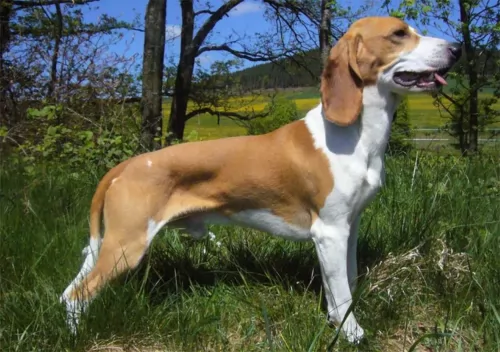 MyDogBreeds
MyDogBreeds Schweizer Niederlaufhund is originated from Switzerland but Blue Picardy Spaniel is originated from France. Schweizer Niederlaufhund may grow 18 cm / 7 inches shorter than Blue Picardy Spaniel. Both Schweizer Niederlaufhund and Blue Picardy Spaniel are having almost same weight. Schweizer Niederlaufhund may live 3 years more than Blue Picardy Spaniel. Both Schweizer Niederlaufhund and Blue Picardy Spaniel has almost same litter size. Schweizer Niederlaufhund requires Low maintenance. But Blue Picardy Spaniel requires Moderate maintenance
Schweizer Niederlaufhund is originated from Switzerland but Blue Picardy Spaniel is originated from France. Schweizer Niederlaufhund may grow 18 cm / 7 inches shorter than Blue Picardy Spaniel. Both Schweizer Niederlaufhund and Blue Picardy Spaniel are having almost same weight. Schweizer Niederlaufhund may live 3 years more than Blue Picardy Spaniel. Both Schweizer Niederlaufhund and Blue Picardy Spaniel has almost same litter size. Schweizer Niederlaufhund requires Low maintenance. But Blue Picardy Spaniel requires Moderate maintenance
 Originating in Switzerland, the Schweizer Niederlaufhund was established around 1900, when hunting became restricted to districts. The Swiss hunter needed a slower dog for the limited territory they could hunt in. Crossing selected Schweizer Laufhunds with Basset Hounds and other selected smaller, short legged hounds developed the Schweizer Niederlaufhund. By 1905 there was already a Schweizer Niederlaufhund Club.
Originating in Switzerland, the Schweizer Niederlaufhund was established around 1900, when hunting became restricted to districts. The Swiss hunter needed a slower dog for the limited territory they could hunt in. Crossing selected Schweizer Laufhunds with Basset Hounds and other selected smaller, short legged hounds developed the Schweizer Niederlaufhund. By 1905 there was already a Schweizer Niederlaufhund Club.
The Niederlaufhund became one of the best hunting dogs in the world, with its powerful body and ability to outhunt the Laufhund in tracking big game. Slower of course than the Laufhund it has a great sense of smell and an ability to easily find wounded animals. There are a few varieties, just like with the Swiss Hound again mostly because of their coloring. The Luzerner Niederlaufhund, the Jura Neiderlaufhund, and the Schwyzerlaufhund. They have musical voices that they use to communicate with the hunters and each other as well as that amazing sense of smell. They can hunt for hours without tiring and without much information from the hunter.
They are a cross breed not recognized by the larger kennel club such as the AKC and the UKC. They are recognized by the Dog Registry of America, Inc. (DRA), the American Canine Association Inc. (ACA) and most importantly by the Federation Cynologique Internationale (FCI). This last one is important because it could lead to recognition as a new breed by the UKC and the AKC.
 The Blue Picardy Spaniel is a direct descendent of the French spaniel. It was in the 14th century that recorded descriptions of the French ‘setting dogs’ emerged but it is believed that the spaniel originated before that.
The Blue Picardy Spaniel is a direct descendent of the French spaniel. It was in the 14th century that recorded descriptions of the French ‘setting dogs’ emerged but it is believed that the spaniel originated before that.
The spaniels separated into different regional types where size and colour varied according to the region they were in. It was developed in the northern part of France and bred with Gordon- and English Setters, resulting in a Belton blue color, which is a type of blue ticking coloration. The dog was recognized as a separate breed in France in 1938.
 The Schweizer Niederlaufhund is a medium size, short dog. They look like their cousins, the Schweizer Laufhund but smaller. Their body is just slightly longer than it is tall, so you are left with the impression of a mostly square dog. The Niederlaufhund is well put together, with strong legs, a noble head, long droopy ears, broad chest, and a low held tail.
The Schweizer Niederlaufhund is a medium size, short dog. They look like their cousins, the Schweizer Laufhund but smaller. Their body is just slightly longer than it is tall, so you are left with the impression of a mostly square dog. The Niederlaufhund is well put together, with strong legs, a noble head, long droopy ears, broad chest, and a low held tail.
The Small Lucerne Hound has a white cote with smooth speckles of black or gray making them appear to be blue.
The Small Bernese Hound has a tricolor coat of white, tan and black. There are tan marks on the eyebrows. There is a wire haired Small Bernese as well. He has a short beard.
The Small Schwyz Hound is smooth coated in white with orange or yellow-red patches. The wired haired version is extinct.
The Small Jura Hound is a single coated dog with a black coat and tan marking above his eyes as eyebrows as well. He might have some white as well.
 The medium-sized, well muscled Blue Picardy Spaniel has such an amicable expression on his face with such gentle brown eyes that it is difficult to think of him as a gun dog. He is often described as a quiet dog, but lots of fun. He has long legs and stands about 56–61 cm high at the withers, weighing about 19–20 kg. His speckled grey-blue coat with black patches is medium length and wavy and you’ll find typical Setter feathering on the legs, the tail and underside. The medium-length, drooping ears are also covered in silky, feathery hair, a blue/grey coat with black patches and has long feathering on the belly, legs, ears and tail. When the puppies are born they’re white with black patches, but this changes as they mature.
The medium-sized, well muscled Blue Picardy Spaniel has such an amicable expression on his face with such gentle brown eyes that it is difficult to think of him as a gun dog. He is often described as a quiet dog, but lots of fun. He has long legs and stands about 56–61 cm high at the withers, weighing about 19–20 kg. His speckled grey-blue coat with black patches is medium length and wavy and you’ll find typical Setter feathering on the legs, the tail and underside. The medium-length, drooping ears are also covered in silky, feathery hair, a blue/grey coat with black patches and has long feathering on the belly, legs, ears and tail. When the puppies are born they’re white with black patches, but this changes as they mature.
The Blue Picardy Spaniel is a loyal and devoted companion, who just loves to spend time with his human family. He loves to work hard and play hard and he makes a splendid family pet. He’ll also get along well with other pets. Treat him with love and care and you’ll find that the Blue Picardy Spaniel is an even-tempered pet who wants to please. Being alert, he will bark to warn you of strangers.
 Children friendliness – yes, they are but use caution around small children and small prey.
Children friendliness – yes, they are but use caution around small children and small prey.
3. Adaptability - needs room to run and explore – is very frustrated when confined.
 The Blue Picardy Spaniel is a gentle, intelligent breed and he responds well to training. He is such an easy going dog who wants to please his owners. They also do well with children and other pets, making him a wonderful family pet.
The Blue Picardy Spaniel is a gentle, intelligent breed and he responds well to training. He is such an easy going dog who wants to please his owners. They also do well with children and other pets, making him a wonderful family pet.
This excellent sporting dog bred in the Picardy region of France is sociable and amicable, a sought after companion animal in France. He is highly trainable breed and his wonderful nature makes him a wonderful choice for first-time dog owners. He is a gentle all-rounder who loves to be with family, making him an exceptional friend.
 The Niederlaufhund Is prone to a very medical issues to keep an eye on. They include:
The Niederlaufhund Is prone to a very medical issues to keep an eye on. They include:
• Hip Dysplasia – This comes from hip joints that are not well formed and cause reduced mobility and pain. Parents can be tested before the dogs are bred to make sure their hips are good, and that dysplasia will not be passed to puppies. This dysplasia can cause arthritis and even lameness.
• Ear Infections – With long drooping ears it is easy for the dog to acquire ear infections. This is even more so for a hunting dog like the Niederlafhund. It is important to clean the dog’s ears on a regular basis.
 The Blue Picardy Spaniel is considered a healthy breed and there are no known genetic health issues. He is a rare dog breed and not excessively bred, meaning they aren’t prone to genetic health problems. When he is loved and well looked after, he can reach 14 years of age and beyond.
The Blue Picardy Spaniel is considered a healthy breed and there are no known genetic health issues. He is a rare dog breed and not excessively bred, meaning they aren’t prone to genetic health problems. When he is loved and well looked after, he can reach 14 years of age and beyond.
You won’t find more health issues with this breed than with other gun dogs. Always be looking out for hip dysplasia, a malformation of the hip joint. The socket of the hip is too shallow, resulting in damage to the joints of the dog, more so as it ages. Symptoms of hip dysplasia include stiffness and trouble with getting up after lying down.
 1Feeding the puppy - give 1 cup per day of high quality dog food divided into 3 meals.
1Feeding the puppy - give 1 cup per day of high quality dog food divided into 3 meals.
2.Feeding the adult – give one and one half cups of high quality dog food divided into 2 meals.
4. Games and Exercises – needs a lot of daily exercise and loves field trials, running and activities like barn hunt.
 The Blue Picardy is an energetic gun dog and he will certainly require a good deal of exercise. If he isn’t running around on a farm you will need to take him for walks regularly or let him off the leash in the park. He is always ready for ball games and just loves to play. It’s why he gets on well with children too- he loves the fun and games he gets.
The Blue Picardy is an energetic gun dog and he will certainly require a good deal of exercise. If he isn’t running around on a farm you will need to take him for walks regularly or let him off the leash in the park. He is always ready for ball games and just loves to play. It’s why he gets on well with children too- he loves the fun and games he gets.
He’ll need a high quality dog food that has been specially formulated for high energy dogs. Always follow the directions on the packaging. Home made food with meat, rice and vegetables is always a welcome change and remember to ensure he gets some raw meat into his diet too. Never deprive him of fresh, cool water. This should be readily available to him 24/7.
The Blue Picardy Spaniel is a moderate shedder with a couple of heavier shedding periods during the year. His grooming requirements are pretty moderate too and he will require a good brush twice a week to get rid of those loose hairs.
Other basic care for your beautiful pet includes clipping his nails, brushing his teeth 2 or 3 times a week, making use of a special dog toothbrush and toothpaste. His ears should certainly be checked for infection.